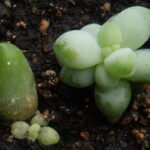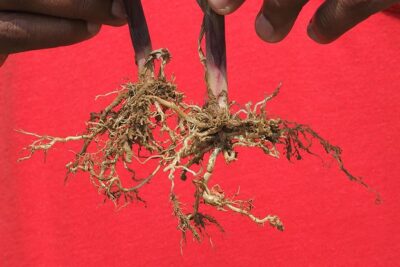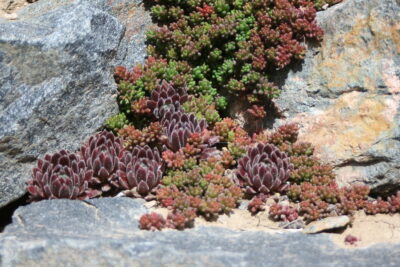
Can Succulent Plants Reproduce and Become Pregnant?

When it comes to plants, reproduction might not be the first thing that comes to mind. However, just like animals, plants have their own unique ways of reproducing and propagating. Succulent plants, known for their thick, fleshy leaves and ability to store water, are no exception. These fascinating plants have adapted to survive in arid environments and have developed interesting methods of reproduction.
We will explore the world of succulent plant reproduction and answer the question of whether succulent plants can become pregnant. We will delve into the different methods succulents use to reproduce, including asexual reproduction through cuttings and offsets, as well as sexual reproduction through flowers and seeds. Additionally, we will discuss the concept of plant "pregnancy" and whether it applies to succulents. So, if you're curious about how these resilient plants propagate and reproduce, keep reading to discover the intriguing world of succulent plant reproduction.
- Yes, succulent plants can reproduce through various methods
- One way is through vegetative propagation, where new plants are grown from cuttings or offsets
- Another method is through sexual reproduction, where succulents produce flowers and seeds
- Succulents can also reproduce by producing plantlets or baby plants
- Some succulent species can even reproduce through fragmentation, where a piece of the plant breaks off and grows into a new plant
- Unlike animals, succulent plants do not become pregnant
- Instead, they reproduce by creating new plants using the methods mentioned above
- Reproduction in succulents is a natural process that allows them to propagate and continue their species
- This ability to reproduce is one of the reasons why succulents are popular houseplants and garden additions
- Frequently Asked Questions
Yes, succulent plants can reproduce through various methods
When it comes to reproduction, succulent plants have some unique and fascinating methods. Unlike animals, succulents do not become pregnant in the traditional sense. However, they have evolved different strategies to reproduce and create new offspring.
1. Offsets or Pups
One common method of reproduction for succulent plants is through the production of offsets or pups. These are miniature versions of the parent plant that grow adjacent to the main plant. Over time, these offsets develop their own roots and can be separated from the parent plant to create new individual plants.
2. Leaf Propagation
Another interesting way succulents reproduce is through leaf propagation. This process involves removing a healthy leaf from the parent plant and allowing it to develop roots. Once the leaf has rooted, it can be planted in soil, and over time, it will grow into a new succulent plant.
3. Stem Cuttings
Succulents can also reproduce through stem cuttings. This method involves cutting a portion of the parent plant's stem and allowing it to dry out and callus. Once the cut end has callused, it can be planted in soil, and roots will eventually form. The cutting will then grow into a new succulent plant.
 Succulent Propagation: A Guide to Time Required
Succulent Propagation: A Guide to Time Required4. Seed Germination
Although less common, succulents can also reproduce through seed germination. This method is similar to how many other plants reproduce. The succulent plant produces flowers, and after pollination, seeds are formed. These seeds can then be collected and planted in soil, where they will germinate and grow into new succulent plants.
5. Grafting
Grafting is a technique used to combine different succulent species or varieties onto a single plant. It involves attaching a small cutting or offset from one succulent onto another, creating a union between the two plants. This method allows for the propagation of unique combinations and can result in stunning and unusual succulent hybrids.
Overall, succulent plants have evolved various methods of reproduction, each with its own unique characteristics. Whether through offsets, leaf propagation, stem cuttings, seed germination, or grafting, succulents have adapted to ensure their survival and continue to captivate us with their beauty.
One way is through vegetative propagation, where new plants are grown from cuttings or offsets
Vegetative propagation is a fascinating method through which succulent plants can reproduce and give birth to new offspring. This process involves the growth of new plants from cuttings or offsets, rather than through seeds.
When it comes to succulents, their ability to reproduce vegetatively is quite remarkable. By taking cuttings from a mature succulent plant, you can effectively clone it and grow a new plant that is genetically identical to its parent. This is a great way to propagate your favorite succulents and expand your collection.
Offsets, also known as pups or babies, are small plantlets that grow at the base of the parent plant. These offsets can be gently removed and planted separately to establish new individual plants. It's like witnessing a miniature version of the parent plant giving birth to its own offspring.
 Indoor Gardening: Growing Spider Web Succulents at Home
Indoor Gardening: Growing Spider Web Succulents at HomeWhether you choose to propagate through cuttings or offsets, the process is relatively simple. First, select a healthy and mature succulent plant. Using a clean and sharp pair of scissors or a knife, carefully cut a stem or a leaf from the parent plant. Make sure to choose a stem or leaf that is free from any signs of disease or damage.
For stem cuttings, remove any leaves from the bottom portion of the stem to expose a clean area for rooting. Allow the cut end of the stem to dry and callus for a few days before planting it in a well-draining soil mix. Keep the soil slightly moist and within a few weeks, you'll start to see roots forming and a new plant taking shape.
If you prefer propagating through offsets, gently separate the baby plant from the parent by carefully cutting or twisting it off. Allow the offset to dry for a few days, similar to stem cuttings, before planting it in a suitable potting mix. Provide the young plant with the right amount of sunlight and water, and soon enough, it will establish itself as an independent succulent.
It is worth noting that not all succulents are capable of vegetative propagation. Some species may only reproduce through seeds or other specialized methods. However, a vast majority of succulent plants can be multiplied through the simple and rewarding process of vegetative propagation.
So, if you've ever wondered whether succulent plants can reproduce and become pregnant, the answer lies in their incredible ability to propagate vegetatively. By taking cuttings or separating offsets, you can witness the miracle of new life sprouting from a single parent plant. It's a truly mesmerizing and rewarding experience for succulent enthusiasts.
Another method is through sexual reproduction, where succulents produce flowers and seeds
When it comes to the reproduction of succulent plants, there are two primary methods: asexual reproduction and sexual reproduction. While asexual reproduction is the more common and efficient method for succulents, sexual reproduction is still a fascinating process that some species undergo.
Sexual Reproduction in Succulent Plants
In order for succulents to reproduce sexually, they must produce flowers. These flowers can vary in size, shape, and color depending on the species. The flowers contain both male and female reproductive organs, allowing for the process of pollination and fertilization.
 Exploring Root Depths in Succulents: Understanding Root Growth
Exploring Root Depths in Succulents: Understanding Root GrowthWhen a succulent plant's flowers bloom, they attract pollinators such as bees, butterflies, or birds. These pollinators transfer pollen from the male reproductive organs (stamens) to the female reproductive organs (pistils) of other flowers. This process enables fertilization to occur.
Once fertilization takes place, the flower will produce seeds. These seeds contain the genetic material necessary for the development of a new succulent plant. The seeds are usually contained within a fruit or pod, which helps protect them and aids in their dispersal.
Over time, the seeds will mature and eventually be released from the plant. They can be dispersed through various means, including wind, water, or being carried by animals. If the conditions are right, the seeds can germinate and grow into new succulent plants.
Advantages of Sexual Reproduction in Succulents
While asexual reproduction is more common, sexual reproduction offers some distinct advantages for succulent plants. One of the main benefits is genetic diversity. Through sexual reproduction, succulents can combine genetic material from different individuals, resulting in offspring with unique traits and characteristics.
This genetic diversity can help succulents adapt to changing environments, resist diseases, and increase their chances of survival. It also allows for the evolution and development of new species over time.
Additionally, sexual reproduction in succulent plants promotes cross-pollination, which can enhance genetic mixing within a population. This mixing can prevent inbreeding and maintain a healthy gene pool.
While asexual reproduction is the primary method for succulent plants, sexual reproduction plays a crucial role in their overall reproductive strategy. Through the production of flowers, pollination, and seed formation, succulents can create offspring with unique traits and genetic diversity, ensuring their long-term survival and adaptation to changing environments.
 Vertical Succulents: Discover Which Types Grow Straight Up
Vertical Succulents: Discover Which Types Grow Straight UpSucculents can also reproduce by producing plantlets or baby plants
Succulents are fascinating plants known for their ability to store water in their leaves, stems, and roots. One of the most intriguing aspects of succulents is their unique reproductive strategies. While most plants reproduce through seeds, succulents have alternative methods to propagate and reproduce.
One of the ways succulents can reproduce is by producing plantlets or baby plants. These plantlets are miniature versions of the parent plant and can grow and develop independently. This process is known as vegetative propagation.
When a succulent plant reaches maturity, it may start producing offsets or plantlets. These offsets are essentially clones of the parent plant and grow as smaller versions at the base or sides of the main plant. They are often referred to as "pups" or "babies" and can be easily detached from the parent plant once they have developed their own root system.
Once separated, these plantlets can be potted individually, allowing them to grow into full-sized succulent plants. This method of reproduction is particularly advantageous for succulent enthusiasts as it provides an opportunity to multiply their collection without relying on seeds.
Propagating succulents through plantlets is a relatively simple process. To do so, carefully remove the plantlet from the parent plant using a clean, sharp knife or scissors. Ensure that the plantlet has a well-developed root system before detaching it. Once removed, place the plantlet in a well-draining potting mix and provide it with adequate sunlight and water. With proper care, it will grow into a healthy and independent succulent plant.
It is important to note that not all succulent species produce plantlets. Some succulents reproduce exclusively through seeds or by other means such as leaf cuttings or stem cuttings. Therefore, if you are interested in propagating a particular succulent, it is essential to research its specific reproductive methods.
Succulents can reproduce by producing plantlets or baby plants. This method of vegetative propagation allows succulent enthusiasts to expand their collection and enjoy the beauty of these unique plants. So, the next time you see a succulent with adorable plantlets, you can appreciate the incredible ability of these plants to reproduce and multiply.
 Can Succulents Easily Spread and Overrun Gardens?
Can Succulents Easily Spread and Overrun Gardens?Some succulent species can even reproduce through fragmentation, where a piece of the plant breaks off and grows into a new plant
One fascinating aspect of succulent plants is their ability to reproduce in various ways. While most plants reproduce through seeds, succulents have some unique methods, including fragmentation. This method involves a piece of the plant breaking off and growing into a new plant.
Fragmentation is a remarkable adaptation that allows succulents to regenerate and propagate themselves. When a portion of a succulent plant detaches from the main plant, it can develop its own root system and eventually grow into a separate individual.
This reproductive strategy is particularly common in certain succulent species, such as sedums, echeverias, and crassulas. These plants often have fleshy, thick leaves that store water, making them more resistant to drought conditions. The ability to fragment and produce new plants enhances their chances of survival in harsh environments.
Fragmentation occurs naturally in some succulents, but it can also be induced by human intervention. Gardeners and succulent enthusiasts often propagate their plants by intentionally breaking off sections and planting them in suitable growing conditions.
When fragmenting a succulent, it is essential to handle the plant with care and ensure that the cutting has enough energy reserves to develop roots. Generally, the cuttings should be allowed to dry and callus before being planted in well-draining soil. Over time, the cutting will establish roots and start growing independently.
It's important to note that not all succulents can reproduce through fragmentation. Some species rely solely on other methods, such as producing offsets or propagating through seeds. Each succulent species has its own unique reproductive strategy, and understanding these processes can help us appreciate the diversity and resilience of these fascinating plants.
 Step-by-Step Guide to Propagating Bear Paw Succulent from a Leaf
Step-by-Step Guide to Propagating Bear Paw Succulent from a LeafUnlike animals, succulent plants do not become pregnant
Unlike animals, succulent plants do not have the ability to become pregnant. Reproduction in succulent plants works differently compared to animals. Instead of getting pregnant, succulent plants have unique methods of reproduction that allow them to create new offspring.
Reproduction through seeds
One common method of reproduction in succulent plants is through the use of seeds. When a succulent plant reaches maturity, it produces flowers that eventually develop into seed pods. These seed pods contain seeds that can be dispersed in various ways, such as through wind, water, or even by animals. Once the seeds find a suitable environment, they can germinate and grow into new succulent plants.
Reproduction through offsets
Another method of reproduction in succulent plants is through offsets, also known as "pups" or "babies." Some succulent plants, like the popular Echeveria or Aloe vera, produce small plantlets that grow at the base of the parent plant. These plantlets can be separated from the parent plant and planted individually, allowing them to develop into independent succulent plants.
Reproduction through leaf cuttings
Many succulent plants have the incredible ability to reproduce through leaf cuttings. This means that by taking a leaf from a mature succulent plant and placing it in a suitable growing medium, it can develop roots and eventually grow into a new plant. This method of reproduction is a popular way for succulent enthusiasts to propagate their plants and expand their collection.
Reproduction through stem cuttings
Similar to leaf cuttings, succulent plants can also reproduce through stem cuttings. By cutting a section of the stem and planting it in the appropriate conditions, it can develop roots and grow into a new plant. This method is particularly useful for succulents with long stems, such as cacti.
While succulent plants may not become pregnant like animals, their unique methods of reproduction allow them to create new offspring and continue their species. Whether it's through seeds, offsets, leaf cuttings, or stem cuttings, succulent plants have fascinating ways of reproducing and expanding their population.
 Propagating Succulent Leaves: A Guide to Growing New Plants
Propagating Succulent Leaves: A Guide to Growing New PlantsInstead, they reproduce by creating new plants using the methods mentioned above
When it comes to succulent plants, their reproductive process is quite fascinating. Unlike animals, succulents do not become pregnant or give birth to offspring. Instead, they have their unique ways of reproducing.
Succulents primarily reproduce through two main methods - sexual reproduction and asexual reproduction. Let's take a closer look at each of these methods:
Sexual Reproduction
In sexual reproduction, succulents rely on pollination to produce seeds. This process involves the transfer of pollen from the male reproductive organs to the female reproductive organs. Most succulents have flowers that attract pollinators like bees, butterflies, or birds.
Once pollination occurs, the female reproductive organ, known as the pistil, develops into a seed pod or fruit. Inside this pod, seeds are formed and mature. When the seeds are fully developed, the pod or fruit opens, releasing them into the environment.
These seeds can then be dispersed by wind, water, or animals. If the conditions are favorable, the seeds can germinate and grow into new succulent plants.
Asexual Reproduction
In addition to sexual reproduction, succulents also have the ability to reproduce asexually. Asexual reproduction allows succulents to create genetically identical offspring without the need for pollination and the production of seeds.
One common method of asexual reproduction in succulents is through stem or leaf cuttings. A healthy stem or leaf is carefully removed from the parent plant and planted in suitable growing medium. Over time, the cutting develops roots and starts growing into a new plant.
 Can You Propagate Donkey's Tail Succulent with Leaf Cuttings?
Can You Propagate Donkey's Tail Succulent with Leaf Cuttings?Another form of asexual reproduction is through offsets or pups. These are small, genetically identical plants that grow from the base of the parent plant. The offsets can be separated from the parent and grown independently, resulting in new succulent plants.
Furthermore, some succulents can produce new plants through bulbils or plantlets. These are miniature versions of the parent plant that grow along the stems or leaves. Once these bulbils or plantlets develop roots, they can be detached and planted to form new plants.
Succulent plants do not become pregnant or give birth to offspring in the way animals do. Instead, they reproduce by creating new plants using the methods mentioned above. Whether it's through sexual reproduction or asexual reproduction, succulents continue to amaze us with their ability to propagate and thrive.
Reproduction in succulents is a natural process that allows them to propagate and continue their species
Succulent plants, known for their thick and fleshy leaves, have evolved unique mechanisms to reproduce and ensure the survival of their species. While they may not become "pregnant" in the traditional sense, succulents are capable of reproducing through various methods, including sexual and asexual reproduction.
 Succulent Propagation: Home Techniques for Thriving Varieties
Succulent Propagation: Home Techniques for Thriving VarietiesSexual Reproduction in Succulents
Sexual reproduction in succulents involves the fusion of male and female reproductive structures, resulting in the formation of seeds. Most succulent species have flowers that produce both male and female reproductive organs.
The male reproductive organs, known as stamens, consist of a filament topped with an anther that contains pollen grains. The female reproductive organs, known as pistils, include the stigma, style, and ovary.
When a succulent plant blooms, it attracts pollinators such as bees, butterflies, or birds, which inadvertently transfer pollen from the stamen to the stigma. The pollen then travels down the style and fertilizes the ovules present in the ovary. This fertilization process leads to the development of seeds within the succulent's fruit.
Asexual Reproduction in Succulents
Succulents are also capable of reproducing asexually, meaning they can produce new plants without the need for pollination or fertilization. This type of reproduction allows succulents to create genetically identical offspring, known as clones.
 Fast-Spreading and Prolific Succulents: A Guide to Rapid Propagation
Fast-Spreading and Prolific Succulents: A Guide to Rapid PropagationOne common method of asexual reproduction in succulents is through vegetative propagation. This process involves the growth of new plants from specialized plant parts, such as leaves, stems, or offsets.
For example, many succulent species produce offsets, also known as "pups" or "babies," which are small plantlets that grow from the base of the parent plant. These offsets can be separated from the parent plant and planted individually to create new succulents.
Similarly, some succulents can reproduce by producing adventitious roots on their stems or leaves. These roots can grow into new plants when provided with the appropriate conditions.
The Importance of Reproduction in Succulents
Reproduction is vital for the survival and proliferation of succulent plants. By reproducing, succulents can increase their population size and colonize new habitats, ensuring the continuity of their species.
Furthermore, succulent plants have adapted to various environmental conditions, such as arid climates, where water and resources may be scarce. Their ability to reproduce asexually allows them to quickly propagate and spread, increasing their chances of survival in challenging environments.
While succulents may not become pregnant in the traditional sense, they have fascinating and diverse methods of reproduction. Whether through sexual or asexual means, succulents ensure the continuation of their species and contribute to the beauty and diversity of our natural world.
This ability to reproduce is one of the reasons why succulents are popular houseplants and garden additions
Succulent plants are known for their unique ability to reproduce and propagate, making them a popular choice for both indoor and outdoor gardening enthusiasts.
Unlike many other plant species, succulents have various methods of reproduction that allow them to multiply and thrive in different environments. One of the most common ways succulents reproduce is through vegetative propagation.
Vegetative Propagation
Vegetative propagation is a method of reproduction where new plants are formed from the existing plant's vegetative parts, such as leaves, stems, or roots. This process does not involve seeds and can occur naturally or be induced by humans.
One of the most well-known examples of vegetative propagation in succulents is leaf propagation. This process involves taking a healthy leaf from a mature plant and allowing it to develop roots and a new plant. The leaf is usually placed on a well-draining soil mix, and with time, it will produce new roots and eventually a small plantlet.
Another form of vegetative propagation is stem cutting. By carefully cutting a stem from the parent plant and allowing it to callus over, it can be planted in a suitable medium to develop roots and grow into a new plant.
Offsets and Pups
Many succulent species also produce offsets or pups, which are small, genetically identical plants that grow from the base of the parent plant. These offsets or pups can be separated from the parent plant and replanted to create new individuals.
Offsets are commonly seen in succulent species like Aloe vera and Echeveria, where small rosettes of leaves form around the base of the main plant. These offsets can be gently detached and planted in their own pots or areas, where they will continue to grow and mature.
Seed Propagation
While most succulents reproduce through vegetative propagation, some species can also be grown from seeds. However, seed propagation can be more challenging and time-consuming compared to other methods.
When succulents produce flowers, they may also produce seeds. These seeds can be collected and sown in a suitable growing medium. It's important to note that not all succulent seeds will germinate successfully, and they may require specific conditions such as temperature, light, and moisture for optimal growth.
Overall, succulents possess incredible reproductive abilities that allow them to multiply and adapt to various conditions. Whether through vegetative propagation, offsets, or seed propagation, these plants continue to fascinate and captivate plant lovers worldwide.
Frequently Asked Questions
1. Can succulent plants reproduce and become pregnant?
No, succulent plants cannot become pregnant. They reproduce through methods such as leaf propagation and stem cuttings.
2. How often should I water my succulent plants?
Succulent plants should be watered sparingly, approximately once every 1-2 weeks depending on the climate and the specific plant's needs.
3. Do succulent plants require direct sunlight?
Yes, most succulent plants thrive in bright sunlight and need at least 4-6 hours of direct sunlight per day. However, it's important to avoid intense midday sun in hotter climates.
4. Can succulent plants survive indoors?
Yes, many succulent plants can survive indoors as long as they receive enough sunlight and are planted in well-draining soil. It's important to avoid overwatering and provide good air circulation.
If you want to read more articles similar to Can Succulent Plants Reproduce and Become Pregnant?, you can visit the Propagation category.






You Must Read